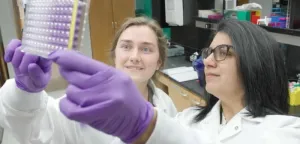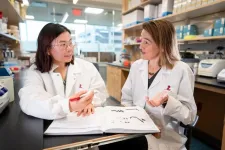(Press-News.org) Obesity is an epidemic in the United States. It has been increasing among adults of all races and ethnicities over the last two decades; however, obesity is higher among Non-Hispanic Black adults, Hispanic adults, and American Indian or Alaska Native adults, than their White and Asian counterparts, according to the National Institutes of Health. Adults with lower income also have higher risk of obesity than those with a high income.
A George Mason University College of Public Health team of interprofessional researchers analyzed the last five years of literature to determine how social and structural determinants of health and social injustice impact the risk of obesity, its treatment and treatment outcomes, and explored the implications for prevention and future treatment interventions.
“We found that social determinants of health, such as where someone lives, and social inequities are primary drivers of obesity disparities,” said Michelle S. Williams, associate professor of community and global health. “Many of these determinants can be modified through interventions to reduce obesity.”
“Population-based, equity-focused interventions that address the underlying causes of obesity disparities are needed to reduce these disparities and improve the health outcomes of minoritized and marginalized groups,” said Lawrence Cheskin, professor of nutrition and food studies. “The good news is that there are successful examples of public health interventions that communities can support to reduce obesity.”
Successful examples include community-based interventions that focus on improving neighborhood conditions, discouraging the consumption of unhealthy foods and beverages, expanding access to obesity treatment, building safe green and play spaces, and ensuring equitable access to fruits and vegetables.
“Even with these known successful interventions, more work needs to be done to expand and broaden programs, activities, and initiatives at the local, state, and national level in the many communities that continue to be negatively impacted by social and structural determinants of health and social injustices,” said Williams. “Public health workers can’t achieve these changes alone; policy makers must include strategies and money for these strategies in their policies at all government levels.”
The researchers conducted a review of literature published within the last five years focused on the social and structural determinants of obesity among minoritized and marginalized adults in the United States.
“Social and Structural Determinants of Health and Social Injustices Contributing to Obesity Disparities” was published online in Current Obesity Reports in June 2024. Sheila J. McKinney from Jackson State University is a co-author on the paper.
Social determinants of health that affect obesity include where someone lives and their access to healthy food, access to health insurance and obesity health care, safe places to be physically active, and policies to promote health behavior.
END
Social and structural factors are key drivers of disparities in obesity rates
Interventions that focus on “modifiable” factors such as access to healthy food, health insurance, and spaces for physical activity are shown to reduce disparities, according to new George Mason University interprofessional research.
2024-08-06
ELSE PRESS RELEASES FROM THIS DATE:
New study helps global MNCs weigh the pros and cons of implementing blockchain technology
2024-08-06
Blockchain technology has become one of the most hyped advancements in recent years, but there hasn’t been a clear understanding of the potential trade-offs for its use by multinational corporations (MNCs). A new study published in the Global Strategy Journal provides a better understanding of blockchain merits and drawbacks by focusing on three particular applications of the technology in this sector: financial transactions, collaboration, and data analytics.
The study, “A perspective on three trade-offs of blockchain technology for the global strategy of the MNC,” was authored by Tuuli Hakkarainen of the University of Liverpool, Anatoli Colicev of the University ...
Increased ventilation not effective in reducing influenza virus spread in play-based model, Emory study finds
2024-08-06
Increasing ventilation in child-care settings may not always be effective at preventing flu virus spread, according to a new study published by a team of researchers at Emory University, University of Pittsburgh School of Medicine, and Virginia Tech.
The spread of flu viruses is commonly studied in animal models that don’t mimic the real-life scenarios of the human experience, making it difficult to evaluate strategies that will be effective in common places where disease spreads rapidly, such as childcare settings. As reported online and in a coming print issue of the journal Proceedings of the National ...
Lonely people tend to have more nightmares, Oregon State University research shows
2024-08-06
CORVALLIS, Ore. – People who are lonely are more apt to have bad dreams, according to a collaboration that included an Oregon State University scientist.
The findings are important because both loneliness and sleep disorders are serious public health issues, said OSU’s Colin Hesse. They are connected to increased risk of heart disease, stroke and premature death.
In a paper published in the Journal of Psychology, Hesse and researchers at the University of Arizona, the University of Tampa and Whitworth University note that stress ...
UC Irvine-led team reveals how TREM2 genetic mutation affects late-onset Alzheimer’s
2024-08-06
Irvine, Calif., Aug. 6, 2024 — Researchers led by the University of California, Irvine have discovered how the TREM2 R47H genetic mutation causes certain brain areas to develop abnormal protein clumps, called beta-amyloid plaques, associated with late-onset Alzheimer’s disease. Leveraging single-cell Merfish spatial transcriptomics technology, the team was able to profile the effects of the mutation across multiple cortical and subcortical brain regions, offering first-of-their-kind insights at the single-cell level.
The study, recently published online in the journal Molecular Psychiatry, compared the brains of normal mice and special mouse models that undergo ...
Considering the patient’s perspective in inducible laryngeal obstruction care
2024-08-06
Inducible laryngeal obstruction is a breathing disorder characterized by unwanted vocal fold closure having the potential to restrict breathing at times.
It’s estimated that between 3-12% of patients with dyspnea complaints have inducible laryngeal obstruction.
Patients with inducible laryngeal obstruction are thought to make up to 22% of patients with frequent emergency room visits due to sudden onset dyspnea.
While experts know how to treat the condition, there’s not much formal research about what patients with the disorder experience ...
Living with a killer: How an unlikely mantis shrimp-clam association violates a biological principle
2024-08-06
Media
When clams gamble on living with a killer, sometimes their luck may run out, according to a University of Michigan study.
A longstanding question in ecology asks how can so many different species co-occur, or live together, at the same time and at the same place. One influential theory called the competitive exclusion principle suggests that only one species can occupy a particular niche in a biological community at any one time.
But out in the wild, researchers find many instances of different species that appear to occupy the same ...
Researchers urge united nations to reject growth-driven framework in favor of lower population and consumption
2024-08-06
In a new peer-reviewed article in The Journal of Population and Sustainability, demographic experts are urging the United Nations to reject the current “‘growth’ paradigm which treats Earth and its nonhuman inhabitants as mere resources” and to take the lead in “contracting the large-scale variables of the human enterprise” in order to “forge a path out of multiple environmental and social crises,” and “reverse our advanced state of ecological overshoot.”
Earth Overshoot Day, the date when humanity’s demand on nature’s resources surpasses Earth’s capacity ...
Future enterovirus outbreaks could be exacerbated by climate change
2024-08-06
Outbreaks of hand, foot and mouth disease (HFMD), which causes fever and rash in young children, typically occur in the summer months. Similarly, historic cases of polio were observed in the summer months in the United States. Both diseases are caused by different species of enteroviruses, a large genus of RNA viruses. However, the drivers of the seasonal patterns of these diseases have remained somewhat unclear.
A common set of drivers can explain the timing of outbreaks of both HFMD and polio according a recent study by researchers at Brown University, Princeton University ...
Genetic ‘episignatures’ guide researchers in identifying causes of unsolved epileptic neurological disorders
2024-08-06
(Memphis, Tenn. – August 6, 2024) To effectively treat a disease or disorder, doctors must first know the root cause. Such is the case for developmental and epileptic encephalopathies (DEEs), whose root causes can be hugely complex and heterogeneous. Scientists at St. Jude Children’s Research Hospital demonstrated the value of DNA methylation patterns for identifying the root cause of DEEs, showing specific gene methylation and genome-wide methylation “episignatures” ...
Study explores effects of racial discrimination on Black parents and children
2024-08-06
URBANA, Ill. – Black Americans experience racial discrimination on a regular basis, and it is a cause of chronic and pervasive stress. It is known to contribute to elevated risk for poor mental health outcomes, but most research has focused on individuals. A new study from the University of Illinois Urbana-Champaign looks at the interpersonal effects of discrimination on parents and their adolescent children.
“A person’s experiences with racial discrimination are not just their own but may spill over into the ...
LAST 30 PRESS RELEASES:
A new way to map how cells choose their fate
Numbers in our sights affect how we perceive space
SIMJ announces global collaborative book project in commemoration of its 75th anniversary
Air pollution exposure and birth weight
Obstructive sleep apnea risk and mental health conditions among older adults
How talking slows eye movements behind the wheel
The Ceramic Society of Japan’s Oxoate Ceramics Research Association launches new international book project
Heart-brain connection: international study reveals the role of the vagus nerve in keeping the heart young
Researchers identify Rb1 as a predictive biomarker for a new therapeutic strategy in some breast cancers
Survey reveals ethical gaps slowing AI adoption in pediatric surgery
Stimulant ADHD medications work differently than thought
AI overestimates how smart people are, according to HSE economists
HSE researchers create genome-wide map of quadruplexes
Scientists boost cell "powerhouses" to burn more calories
Automatic label checking: The missing step in making reliable medical AI
Low daily alcohol intake linked to 50% heightened mouth cancer risk in India
American Meteorological Society announces Rick Spinrad as 2026 President-Elect
Biomass-based carbon capture spotlighted in newly released global climate webinar recording
Illuminating invisible nano pollutants: advanced bioimaging tracks the full journey of emerging nanoscale contaminants in living systems
How does age affect recovery from spinal cord injury?
Novel AI tool offers prognosis for patients with head and neck cancer
Fathers’ microplastic exposure tied to their children’s metabolic problems
Research validates laboratory model for studying high-grade serous ovarian cancer
SIR 2026 delivers transformative breakthroughs in minimally invasive medicine to improve patient care
Stem Cell Reports most downloaded papers of 2025 highlight the breadth and impact of stem cell research
Oxford-led study estimates NHS spends around 3% of its primary and secondary care budget on the health impacts of heat and cold in England
A researcher’s long quest leads to a smart composite breakthrough
Urban wild bees act as “microbial sensors” of city health.
New study finds where you live affects recovery after a hip fracture
Forecasting the impact of fully automated vehicle adoption on US road traffic injuries
[Press-News.org] Social and structural factors are key drivers of disparities in obesity ratesInterventions that focus on “modifiable” factors such as access to healthy food, health insurance, and spaces for physical activity are shown to reduce disparities, according to new George Mason University interprofessional research.



